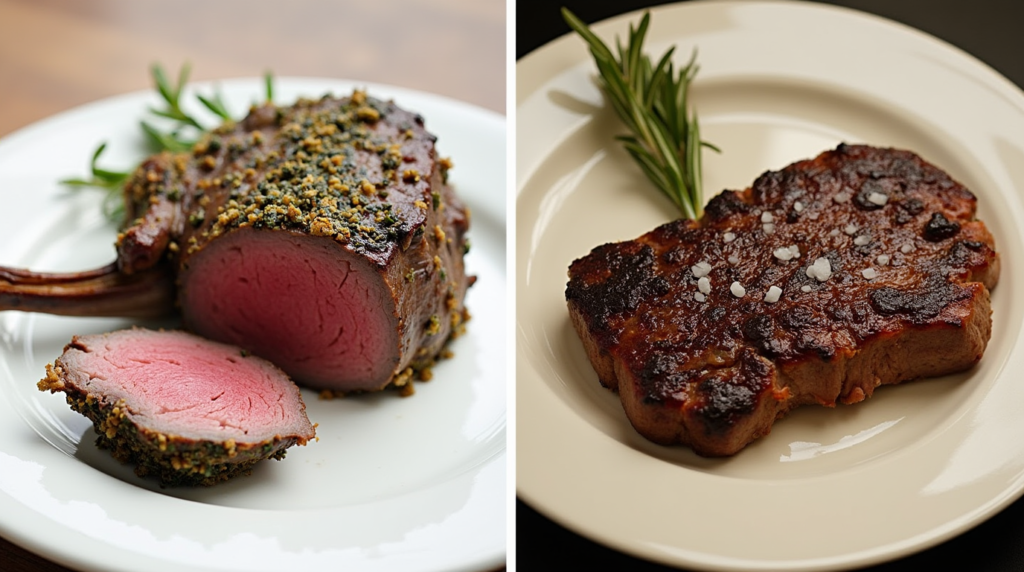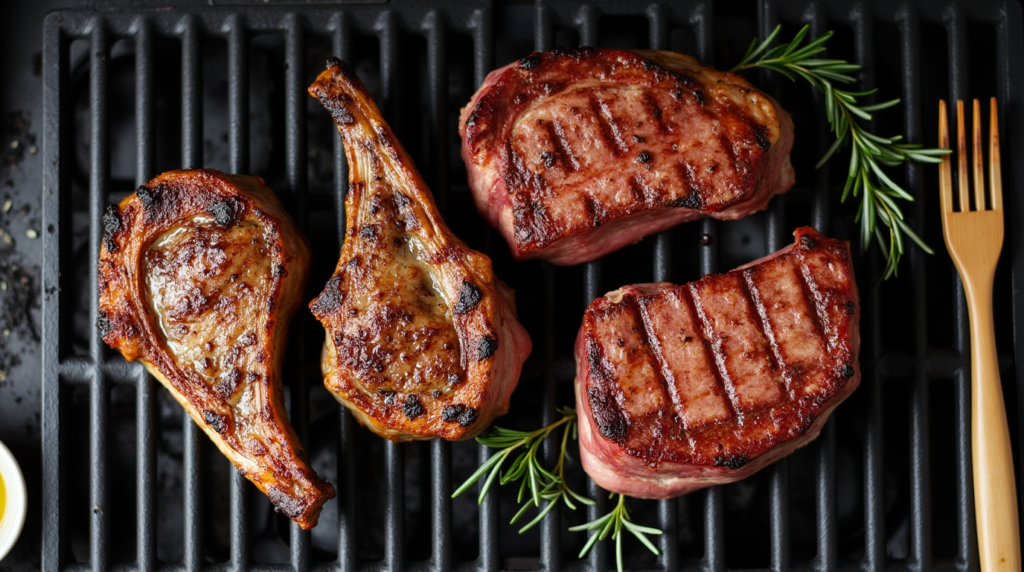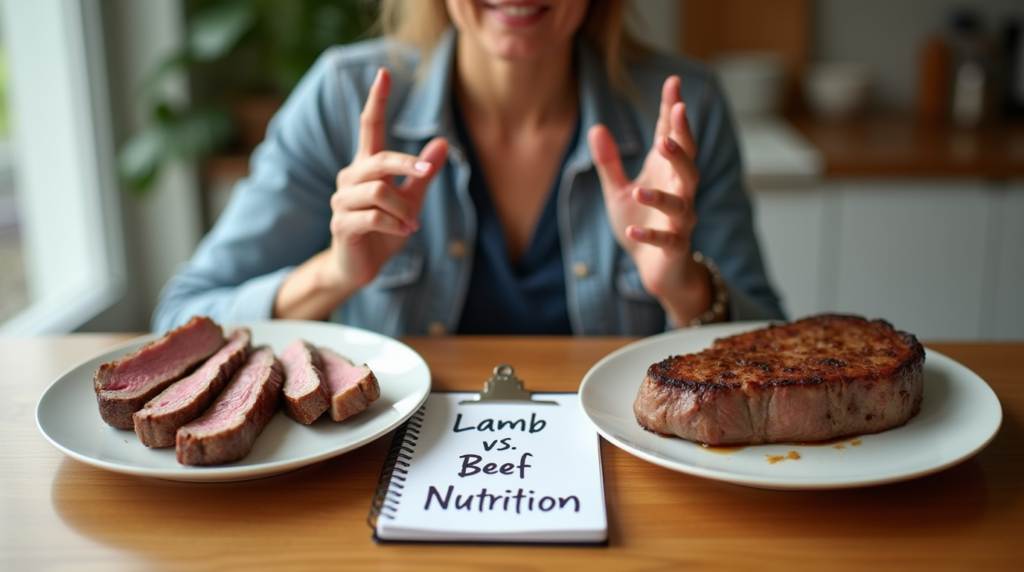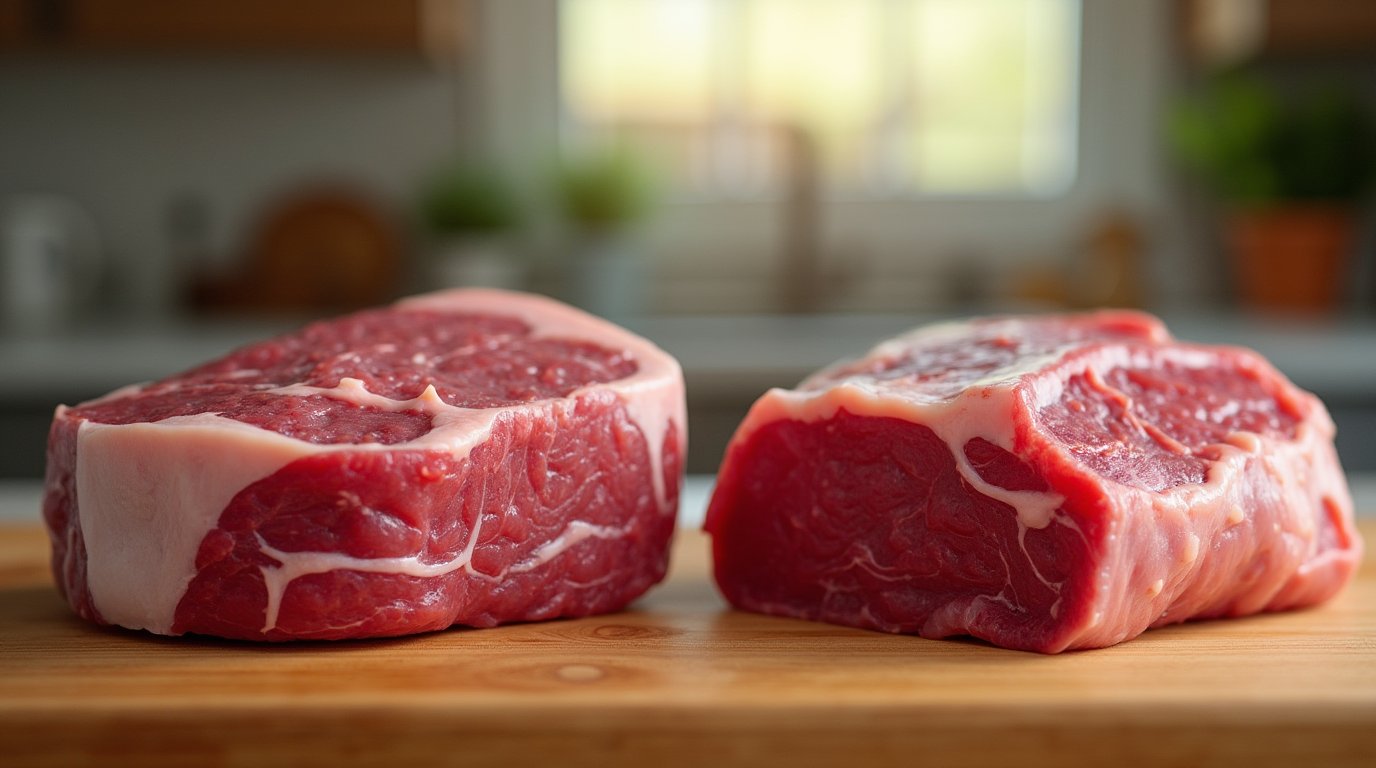When it comes to choosing red meat for a healthy diet, Is Lamb Healthier Than Beef? is a common question. Both lamb and beef are popular sources of protein, but they offer different nutritional profiles and health benefits.
In this comprehensive guide, we will explore the lamb vs. beef health benefits, determine the healthiest red meat, and provide a detailed nutritional comparison of lamb and beef. If you’re wondering about preparation methods, check out What Cooking Method Is Best for Lamb? for tips on maximizing flavor and nutrition.
Additionally, knowing how to store your cooked meat is crucial for health and safety—learn more at Cooked Meat Storage Duration.
Whether you’re debating between lamb or beef for a healthy diet, this article will help you make an informed decision based on a red meat nutrition comparison.
Introduction to Lamb and Beef
Overview of Lamb as a Dietary Protein
Lamb is a versatile red meat known for its rich flavor and tender texture. It is a staple in many cuisines around the world, particularly in Mediterranean, Middle Eastern, and South Asian dishes. Additionally, lamb is often praised for its high-quality protein content, which is essential for muscle growth and repair. Moreover, it contains essential vitamins and minerals that contribute to overall health.
Overview of Beef as a Dietary Protein
Beef, on the other hand, is one of the most widely consumed meats globally. It is celebrated for its robust flavor and versatility in various culinary applications, from steaks and roasts to ground beef dishes.
Furthermore, beef is a significant source of protein, iron, and B-vitamins, making it a valuable component of many diets. Its availability and variety make it a popular choice for meals across different cultures.
Why Compare Lamb and Beef?
Comparing lamb and beef is important for those looking to optimize their diet for health benefits. By conducting a nutritional comparison of lamb and beef, consumers can make informed choices based on their dietary needs and health goals.
Additionally, understanding the healthiest red meat can help individuals balance taste preferences with nutritional value, ensuring a well-rounded and health-conscious diet.
Nutritional Profiles of Lamb and Beef
Calories and Macronutrient Breakdown
When comparing lamb vs. beef health benefits, it’s essential to examine their calorie and macronutrient profiles. Generally, lamb tends to be higher in calories and fat compared to beef.
For instance, a 100-gram serving of cooked lamb typically contains around 294 calories, 25 grams of protein, and 21 grams of fat. In contrast, the same serving size of cooked beef contains approximately 250 calories, 26 grams of protein, and 15 grams of fat.
- Lamb (100g cooked):
- Calories: 294
- Protein: 25g
- Fat: 21g
- Beef (100g cooked):
- Calories: 250
- Protein: 26g
- Fat: 15g
Moreover, the type of fat present in each meat plays a significant role in their health implications. Lamb usually has a higher proportion of saturated fats, which can impact heart health if consumed in excess.
Conversely, beef offers a balance of saturated and unsaturated fats, making it a slightly better option for those monitoring their fat intake.

Vitamin and Mineral Content
Furthermore, both lamb and beef are excellent sources of essential vitamins and minerals. Lamb is particularly rich in vitamin B12, zinc, and iron, which are crucial for maintaining healthy blood cells, immune function, and energy metabolism.
Additionally, lamb provides a good amount of selenium and phosphorus, contributing to thyroid health and bone strength.
Similarly, beef is a powerhouse of nutrients, offering high levels of vitamin B12, niacin, and riboflavin. These vitamins support nervous system health, energy production, and red blood cell formation. Moreover, beef is abundant in iron, which is vital for preventing anemia and maintaining overall vitality.
Consequently, both meats offer significant nutritional benefits, making them valuable additions to a balanced diet.
Comparison of Fats: Saturated, Unsaturated, and Omega-3s
Another critical aspect of the lamb vs. beef health benefits comparison is the fat composition. Lamb generally contains higher levels of saturated fats, which have been linked to increased cholesterol levels and heart disease risk. However, lamb also provides beneficial omega-3 fatty acids, especially in grass-fed varieties, which support brain health and reduce inflammation.
In contrast, beef contains a lower proportion of saturated fats and a higher amount of monounsaturated and polyunsaturated fats. These healthier fats help improve cholesterol levels and reduce the risk of heart disease.
Additionally, beef offers some omega-3 fatty acids, though in smaller quantities compared to lamb. Therefore, while both meats contain healthy fats, beef may have a slight edge in promoting heart health due to its favorable fat profile.
Cooking and Preparation Differences
Popular Cooking Methods for Lamb
When it comes to cooking and preparation differences, lamb and beef require different approaches to highlight their unique flavors and textures. Popular cooking methods for lamb include roasting, grilling, braising, and slow-cooking. These methods help tenderize the meat and enhance its rich, gamey flavor.
Additionally, marinating lamb before cooking can infuse it with additional flavors, making it even more delicious and aromatic.
Popular Cooking Methods for Beef
In contrast, beef’s versatility allows it to be used in a wide array of recipes across different cuisines. Grilling, pan-searing, roasting, and braising are common techniques that bring out beef’s robust flavor and tender texture. Moreover, different cuts of beef, such as steaks, roasts, and ground beef, lend themselves to specific cooking methods, allowing for a wide range of culinary creations.
Consequently, beef’s versatility makes it a favorite choice for diverse recipes and meal preparations.
How Cooking Affects Nutritional Content
Additionally, cooking methods can significantly impact the nutritional content of lamb and beef. High-heat cooking techniques like grilling and frying can reduce the levels of certain vitamins and minerals, while slow-cooking methods help preserve them.
Moreover, overcooking meat can lead to the formation of harmful compounds, so it’s essential to cook lamb and beef properly to maintain their nutritional value. Therefore, choosing the right cooking method ensures that you maximize the health benefits of both meats while enjoying their delicious flavors.

Dietary Preferences and Restrictions
Lamb for Keto and Paleo Diets
For those following specific dietary preferences, lamb and beef offer distinct advantages. For instance, lamb is an excellent choice for keto and paleo diets due to its high protein and fat content.
Additionally, lamb is naturally free from carbohydrates, making it ideal for low-carb and ketogenic meal plans.
Consequently, incorporating lamb into these diets can support weight loss, muscle gain, and overall metabolic health.
Beef for High-Protein Diets
Conversely, beef is a powerhouse for high-protein diets, providing ample protein necessary for muscle building and maintenance. Moreover, beef’s rich nutrient profile, including essential amino acids and vitamins, makes it a valuable component of protein-focused meal plans.
Additionally, beef can be easily incorporated into various recipes, offering flexibility for those seeking to increase their protein intake. Therefore, beef is an excellent option for individuals aiming to enhance their protein consumption for fitness and health.
Considerations for Allergies and Intolerances
However, it’s important to consider allergies and intolerances when choosing between lamb and beef. While both meats are generally well-tolerated, some individuals may have specific sensitivities or allergic reactions. Therefore, those with beef allergies might prefer lamb as a safer alternative, and vice versa. Additionally, cross-contamination in processing facilities can pose risks for individuals with severe allergies. Consequently, reading labels and consulting with healthcare providers can help manage dietary restrictions effectively.
Culinary Uses and Flavor Profiles
The Distinct Flavor of Lamb
Lamb boasts a distinct, rich flavor that sets it apart from other meats. Its slightly gamey taste is complemented by its tender texture, making it a favorite in gourmet and traditional dishes alike.
Additionally, lamb pairs well with robust herbs and spices such as rosemary, garlic, and thyme, enhancing its natural flavors. Consequently, lamb is often featured in hearty stews, roasted dishes, and Mediterranean specialties, where its unique taste can shine.
Versatility of Beef in Recipes
In contrast, beef’s versatility allows it to be used in a wide array of recipes across different cuisines. From juicy steaks and succulent roasts to flavorful ground beef dishes like burgers and tacos, beef adapts well to various cooking methods and flavor profiles.
Moreover, beef can be marinated, seasoned, and paired with a multitude of ingredients, making it an essential component in diverse culinary traditions.
Therefore, beef’s adaptability makes it a staple in kitchens worldwide, suitable for both everyday meals and special occasions.
Combining Both Proteins for Diverse Meal Options
Furthermore, combining lamb and beef in meal preparations can offer a balanced and diverse dining experience. For example, mixed meat dishes like meatloaf or shepherd’s pie can incorporate both meats, providing a blend of flavors and textures.
Additionally, using both lamb and beef in grilling or barbecue can create a variety of taste sensations, catering to different preferences within a single meal.
Consequently, leveraging the strengths of both proteins can enhance culinary creativity and satisfy a broader range of palates.
Conversions Chart for Metric Measurements
Metric to Imperial Conversions for Key Ingredients
| Ingredient | Metric | Imperial |
|---|---|---|
| Flour (All-Purpose) | 1 cup = 125 g | 1 cup = 125 g |
| Sugar (Granulated) | 1 cup = 200 g | 1 cup = 200 g |
| Butter | 1 stick = 113 g | 1 stick = 113 g |
| Milk | 240 ml | 1 cup = 240 ml |
| Eggs | 1 large = 50 g | 1 large = 50 g |
| Baking Powder | 5 g | 1 teaspoon = 5 g |
| Salt | 6 g | 1 teaspoon = 6 g |
Note: These conversions are approximate. Therefore, for best results, use a kitchen scale to measure ingredients by weight.
How to Convert Volume to Weight for Accuracy
Converting volume measurements (cups, tablespoons) to weight (grams) ensures greater precision in your lamb vs. beef health benefits and other recipes. Therefore, to convert, use the following guidelines:
- 1 cup of all-purpose flour ≈ 125 grams
- 1 cup of granulated sugar ≈ 200 grams
- 1 cup of butter ≈ 227 grams
- 1 cup of milk ≈ 240 grams
Additionally, using a digital kitchen scale simplifies this process, allowing you to measure ingredients accurately and consistently for perfect results every time.
Recommended Tools for Easy Conversions
Having the right tools can make cooking and baking with metric measurements easier and more enjoyable. Therefore, essential tools include:
- Digital Kitchen Scale: Provides precise measurements in grams and kilograms.
- Measuring Spoons: Accurate for small quantities of ingredients like baking powder and salt.
- Measuring Cups: Useful for liquid ingredients like milk and oil.
- Conversion Chart or App: Handy for quick reference when switching between metric and imperial units.
- Mixing Bowls: Multiple sizes help organize ingredients and streamline the mixing process.
Consequently, investing in these tools ensures that your nutritional comparison of lamb and beef and other culinary endeavors are efficient and successful.

Frequently Asked Questions About Lamb and Beef
Which is more sustainable: lamb or beef?
From an environmental perspective, beef is generally considered more sustainable than lamb due to its lower carbon footprint and higher feed conversion efficiency.
However, sustainability can vary based on farming practices, feed types, and regional factors. Therefore, choosing sustainably raised beef or lamb from farms that prioritize eco-friendly practices can enhance the sustainability of your meat consumption.
Additionally, supporting local and ethical farming practices contributes to a more sustainable food system overall.
What are the best cuts of lamb and beef for grilling?
For grilling, the best cuts of lamb include lamb chops, leg of lamb, and lamb kebabs, which offer tenderness and rich flavor. Similarly, popular beef cuts for grilling are ribeye, sirloin, T-bone, and flank steak, known for their marbling and juicy texture.
Additionally, marinating these cuts before grilling can enhance their flavor and tenderness. Therefore, selecting the appropriate cuts is essential for achieving delicious and perfectly grilled meals.
Final Thoughts
Deciding whether lamb is healthier than beef involves evaluating their nutritional profiles, health benefits, environmental impact, and personal dietary needs.
By conducting a nutritional comparison of lamb and beef, you can make informed choices that align with your health goals and ethical values. Whether you prefer the rich flavor of lamb or the versatility of beef, both can be part of a balanced and nutritious diet when consumed mindfully.
Ultimately, incorporating a variety of high-quality red meats can enhance your meals, support your health, and contribute to a sustainable and responsible food system.

